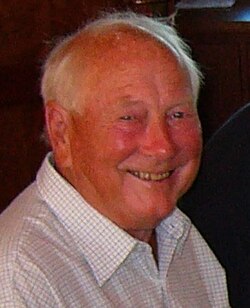Bjørn G. Andersen
| Bjørn G. Andersen | |
|---|---|

Bjørn G. Andersen on the excursion to Greenland 2005.
|
|
| Born | Bjørn Grothaug Andersen 23 March 1924 Stavanger, Rogaland, Norway |
| Died | 12 January 2012 (aged 87) Asker, Akershus |
| Nationality | Norwegian |
| Fields | Quaternary geology, Glaciology |
| Institutions |
University of Oslo Yale University University of Bergen |
| Doctoral advisor | Olaf Holtedahl |
| Spouse | Astrid E. Kruse Andersen |
Bjørn Grothaug Andersen (23 March 1924, in Stavanger, Norway – 12 January 2012, in Asker, Norway) was a Norwegian professor of Quaternary geology and glaciology who made foundational contributions to glacial geology and the understanding of climate change.
Andersen was the son of Knut Severin Andersen b. Grothaug (1882–1948), from Hornindal in Nordfjord, who was a gardener in Stavanger, and Elise Andersen b. Rafoss (1890–1987) from Stavanger (Kvinesdal). Because his father was a gardener they had a car, which was rare at the time, and using this they went on skiing in the winter and fishing in the summer. He enjoyed going for long skiing tours in the mountains in Stavanger, when he was young, and several times he crossed Trollgaren in Ryfylke, this marvelous moraine that is appropriate to its name. He wondered how it was formed, and was told by the local farmer that it was really Trolls that had set up the meandering fence of huge boulders, far above the tree line. The curiosity for this natural phenomenon in addition to many others in turn led to his interest for the Ice Age.
In 1951 he married the physiotherapist Astrid E. Kruse Andersen (born 1926). After a Research Fellowship at Yale University under Richard Foster Flint in 1954–1956, Andersen was a professor of Quaternary geology at the University of Oslo from 1956 to 1970, then at the University of Bergen from 1970 to 1982. Then he returned to the University of Oslo and worked there for 9 years until retirement. He headed the geological institutes both in Oslo and Bergen. He was responsible for the geological education of more than 30 year groups of students, and he continued to participate in academic society until autumn 2011, when he had developed cancer and was in poor health. Andersen was a sought after lecturer and was acclaimed by his students, some of whom he kept in contact with until his death in January 2012.
...
Wikipedia
